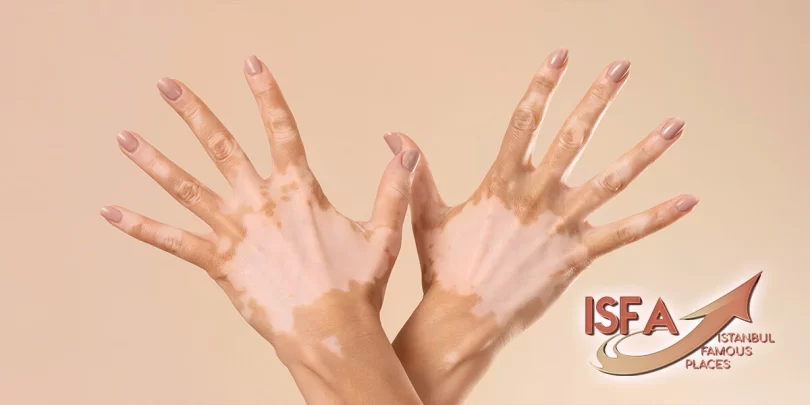What is Vitiligo Istanbul?
Vitiligo Istanbul is a chronic skin condition characterized by the loss of pigment, or color, in certain areas of the skin, resulting in white patches or depigmentation. The condition occurs when melanocytes, the cells responsible for producing melanin, which gives skin its color, are destroyed or stop functioning properly.
Vitiligo Istanbul can affect any area of the body, but it commonly occurs on the face, hands, arms, feet, and areas around body openings, such as the eyes and mouth. The exact cause of vitiligo Istanbul is not fully understood, but it is believed to involve a combination of genetic, autoimmune, and environmental factors.
Is Vitiligo Istanbu Internal Organ Disease?
Vitiligo Istanbul is primarily a skin disorder characterized by the loss of pigment in certain areas of the skin, resulting in white patches or depigmentation. While the condition primarily affects the skin, it is considered to be an autoimmune disorder, meaning that the immune system mistakenly targets and attacks healthy melanocytes, the cells responsible for producing melanin, which gives skin its color.
Is Vitiligo A Disease With Treatment?
Yes, vitiligo is a chronic skin condition that can be managed with various treatment options. While there is currently no cure for vitiligo, treatment aims to restore pigment to the affected areas of the skin and may help to improve the appearance of depigmented patches.
Treatment options for vitiligo vary depending on factors such as the extent of depigmentation, the location of affected areas, and individual preferences. Some common treatment approaches include:
Topical corticosteroids: These medications are applied directly to the affected areas of the skin and may help to reduce inflammation and promote repigmentation.
Phototherapy: Phototherapy involves exposing the skin to ultraviolet (UV) light, either through narrowband UVB therapy or PUVA (psoralen plus ultraviolet A) therapy. Phototherapy can stimulate melanocyte activity and promote repigmentation of the skin.
Topical calcineurin inhibitors: These medications modulate the immune response in the skin and may help to promote repigmentation in affected areas.
Surgical procedures: In cases where other treatments have not been effective, surgical options such as skin grafting, melanocyte transplantation, and micropigmentation (tattooing) may be considered to restore pigment to the affected areas.
It is important to consult with a dermatologist or healthcare provider to determine the most appropriate treatment approach based on individual factors and preferences. While treatment may help to manage vitiligo and improve the appearance of depigmented patches, results can vary, and complete repigmentation may not always be achievable.
Can Herbal Products Treat this Pigmentation Disorder?
Some individuals with vitiligo Istanbul may explore the use of herbal products or alternative therapies as part of their treatment approach. While there is limited scientific evidence to support the effectiveness of herbal remedies for vitiligo Istanbul, some herbal products may have potential benefits in managing symptoms or supporting overall skin health.
Common herbal products and natural remedies that are sometimes used for vitiligo Istanbul include:
Ginkgo biloba: Some research suggests that ginkgo biloba, an herbal supplement derived from the leaves of the ginkgo tree, may have antioxidant and immunomodulatory effects that could potentially benefit individuals with vitiligo Istanbul. However, more research is needed to determine its efficacy and safety for this use.
Psoralen-containing plants: Psoralen is a naturally occurring compound found in certain plants, such as psoralea corylifolia (babchi or bakuchi) and Ammi majus (khellin). Psoralen-containing plants have been traditionally used in combination with UVA phototherapy (PUVA) to treat vitiligo Turkey by stimulating pigmentation in the skin.
Turmeric: Turmeric, a spice derived from the Curcuma longa plant, contains the active compound curcumin, which has antioxidant and anti-inflammatory properties. Some studies suggest that topical application of turmeric extract or oral supplementation with curcumin may have potential benefits for individuals with vitiligo Turkey.
Black cumin seed oil: Black cumin seed oil, derived from the seeds of the Nigella sativa plant, has been used traditionally in various cultures for its purported health benefits. Some studies suggest that topical application of black cumin seed oil may help to promote repigmentation in individuals with vitiligo Turkey.
It is important to note that while some herbal products may have anecdotal or traditional use in the treatment of vitiligo Turkey, scientific evidence supporting their effectiveness and safety is often limited. Additionally, herbal remedies can vary in quality, purity, and potency, and may interact with medications or cause adverse effects in some individuals.
Is There a Surgical Treatment for Vitiligo?
Yes, there are surgical treatment options available for vitiligo, particularly for cases where other treatments have not been effective or for individuals with stable vitiligo. Some common surgical procedures for vitiligo include:
Skin grafting: In this procedure, healthy skin from another part of the body (the donor site) is transplanted to the areas affected by vitiligo. This can be done using various techniques, such as punch grafting, split-thickness grafting, or suction blister grafting. The transplanted skin contains melanocytes, which can help repigment the affected areas.
Melanocyte transplantation: This procedure involves harvesting melanocytes (pigment-producing cells) from a small section of healthy skin and transplanting them to the depigmented areas. Melanocyte transplantation can be performed using techniques such as noncultured epidermal suspension transplantation or cultured melanocyte transplantation.
Tattooing (micropigmentation): In some cases, medical tattooing may be used to camouflage depigmented areas by implanting pigment into the skin. This technique can help to blend the depigmented patches with the surrounding skin, providing a more uniform appearance.
Surgical treatments for vitiligo are typically performed by dermatologists or plastic surgeons experienced in treating the condition. The choice of surgical procedure depends on factors such as the extent and location of depigmentation, skin type, and individual preferences. It is important to discuss the potential benefits, risks, and expectations of surgical treatment with a healthcare provider.
What Should Vitiligo Istanbul Patients Pay Attention To?
Individuals with vitiligo Istanbul should pay attention to several factors to help manage their condition and maintain overall skin health. Some important considerations include:
Sun protection: Protecting the skin from sun exposure is crucial for individuals with vitiligo, as sunburn can exacerbate depigmentation and increase the risk of developing new patches. It is recommended to use broad-spectrum sunscreen with a high SPF, wear protective clothing, and seek shade during peak sun hours.
Regular medical follow-up: It is important for individuals with vitiligo Istanbul to have regular medical follow-up appointments with a dermatologist or healthcare provider experienced in treating the condition. Regular monitoring can help track disease progression, assess treatment effectiveness, and address any concerns or complications.
Emotional well-being: Vitiligo Istanbul can have significant psychosocial impacts on affected individuals, leading to feelings of self-consciousness, low self-esteem, and emotional distress. It is important to prioritize emotional well-being and seek support from friends, family members, or mental health professionals if needed.
Healthy lifestyle habits: Maintaining a healthy lifestyle, including regular exercise, a balanced diet, adequate hydration, and sufficient sleep, can help support overall skin health and immune function. Some individuals with vitiligo may also benefit from dietary modifications or supplements, although more research is needed in this area.
How did your vitiligo start?
The onset of vitiligo can vary widely among individuals, and the exact cause of the condition is not fully understood. Vitiligo typically begins with the appearance of small, white patches or depigmented areas on the skin. These patches may initially be subtle and may go unnoticed until they become more prominent or spread to other areas of the body.
The progression of vitiligo can be unpredictable, with some individuals experiencing rapid onset and progression of depigmentation, while others may have a more gradual or stable course. The development of vitiligo patches may be associated with triggers such as sun exposure, skin trauma, emotional stress, or underlying medical conditions.
While the exact cause of vitiligo is not known, it is believed to involve a combination of genetic, autoimmune, and environmental factors. Vitiligo is considered to be an autoimmune disorder, meaning that the immune system mistakenly targets and attacks healthy melanocytes, the cells responsible for producing melanin, which gives skin its color. Genetic predisposition may also play a role, as individuals with a family history of vitiligo are at increased risk of developing the condition.
Other factors that may contribute to the development of vitiligo include oxidative stress, neurochemical factors, viral infections, and hormonal imbalances. However, more research is needed to fully understand the complex mechanisms underlying the onset and progression of vitiligo.
Can vitiligo go away naturally?
In some cases, vitiligo patches may repigment or fade over time without treatment, a phenomenon known as spontaneous repigmentation. Spontaneous repigmentation occurs when melanocytes, the pigment-producing cells in the skin, reappear or migrate to the depigmented areas, resulting in the restoration of skin color.
The likelihood of spontaneous repigmentation occurring varies widely among individuals and depends on factors such as the extent and location of depigmentation, the presence of underlying autoimmune or inflammatory conditions, and individual differences in immune response and melanocyte function.
While spontaneous repigmentation can occur, it is not guaranteed, and the process may be slow and unpredictable. In many cases, vitiligo remains stable or may continue to progress over time, leading to the development of new depigmented patches.
Treatment options for vitiligo are available to help promote repigmentation and manage the condition, even if spontaneous repigmentation does not occur. These may include topical corticosteroids, phototherapy (light therapy), topical calcineurin inhibitors, excimer laser therapy, and surgical techniques such as skin grafting or melanocyte transplantation.
Individuals with vitiligo who are interested in treatment options should consult with a dermatologist or healthcare provider experienced in treating the condition. A personalized treatment plan can be developed based on the individual’s preferences, medical history, and the extent and characteristics of their vitiligo.
Vitiligo Istanbul Cost 2024
The clinic or hospital selected, the particular treatment plan, the length of the course of therapy, and the experience of the medical staff treating the patient are some of the variables that might affect the cost of vitiligo treatment in Istanbul. The size of the damaged region and the number of therapy sessions needed may also have an effect on the total cost.

